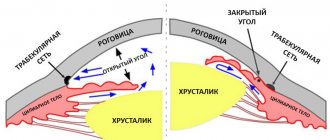We quite often experience discomfort in the eyes - something has got into the eye, but what is unclear, and how to get it out, too. The cause of the discomfort is not visible in the mirror, and attempts to blink do not give the desired effect. Doctors have several tips for you in this case - how to remove the speck quickly and safely.
First you need to prepare a few things that will help you carry out the manipulation.
- cotton swab or clean lint-free cloth (moisten with boiled water or saline solution)
- saline solution or eye drops
- mirror
- eye wash cup.
Hands should be washed clean and dry. Don't use towels with lint, otherwise you may end up with more debris in your eye. Lighting should be sufficient, natural daylight is the best.
You may need an assistant.
How can you be sure there is a speck in your eye?
You don’t need to be a specialist to understand that a foreign body has entered your eye. Often this is an insect, hair, eyelash, grain of sand, microscopic fragment of glass or other material, as well as other objects with sharp edges. Regardless of the nature of the foreign object that gets on the surface of the eye, this phenomenon is accompanied by the same symptoms. The most obvious signs of a problem are listed below:
· Painful sensations in the eye, which intensify when blinking and changing the direction of gaze.
· Severe burning and irritation of the eye, desire to constantly rub the eye due to severe itching.
· Redness of the surface of the eye where the speck is located, an unpleasant feeling of pressure.
· Blurred vision, the appearance of a veil before the eye, increased tearing.
· Increased sensitivity to light; when looking at light sources, the eyes begin to water heavily.
· Bleeding or subconjunctival hemorrhage in the eyeball, pain.
If you have one or more of the above symptoms at the same time, and you do not wear contact lenses, then there is a high probability that a foreign object has entered your eye. If such an object hits the eye at high speed, for example while driving without safety glasses or a helmet, it can cause serious eye injury. In this case, emergency assistance from a specialist will be required.
If a foreign body has entered the eye and does not leave it with increased blinking, special measures will need to be taken to remove the foreign object from the eye. This can be done at home, but you need to properly prepare and correctly perform the procedure. Otherwise, you can only do harm. Let us look in detail at what needs to be done in order to painlessly and safely clear the eye of objects.
Signs of foreign body entry
Symptoms caused by foreign objects entering the eye can vary widely:
- mild discomfort or intense pain;
- redness of the eye;
- burning sensation;
- increased lacrimation;
- photophobia;
- reflex closing of the eyelids, difficulty when trying to open the affected eye;
- blurred vision.
The severity of the clinical picture depends on the type of foreign body, its size and location.
What measures should I take before deleting?
The very first thing you need to do before you start cleaning your eye from a foreign object that has gotten into it is to take care of hand hygiene. If you perform the procedure with dirty hands, you can get a lot of problems, including infection of the eye organs. Also, cleaning the eye without prior hand hygiene can lead to the introduction of new foreign bodies into the cornea and conjunctiva. Hand hygiene before removing debris from the eye will not take up too much of your time. It is enough to wash your hands with soap and clean water, then dry them thoroughly with a dry towel. It is not recommended to wipe your hands with alcohol and alcohol-containing substances, since the contact of alcohol and the surface of the eye in 100% of cases causes severe irritation of the visual organs. This will only interfere with your procedure.
Principles of treatment
The main goal of treatment is to restore the integrity of the eye and remove the foreign body. The timing of removal may be determined by several factors, including the nature and location of the foreign body, the availability of necessary equipment, and qualified medical personnel.
The greatest danger to the eye comes from organic foreign bodies (plant parts), which quickly rot, which causes a powerful inflammatory process. They require particularly quick removal. However, in any other cases it is also necessary to remove the foreign body from the eye as quickly as possible.
Prevention of infectious complications must be carried out, which is done by intramuscular, intravenous or local (near or inside the eye) administration of antibiotics and anti-inflammatory drugs. If necessary, a tetanus vaccination is given.
The development of siderosis and chalcosis requires, after removal of the foreign body, a course of detoxification therapy, with maximum removal of toxic products from the eye.
Correct instructions for removing debris
In fact, there is nothing difficult about correctly and without negative consequences removing a speck that has gotten into the eye. You can start the procedure immediately after you make sure that your hands are clean and dry. Follow the algorithm below to ensure that the foreign body is removed without pain:
1. Turn on the warm water supply, place your palms together to form a handful, and scoop a small amount of water into it. Open your eyes wide and rinse your face generously in this position. If a foreign object that gets onto the surface of the eye is an ordinary speck of dust, already at this stage it will be washed far beyond the organ. You will feel relief immediately after this.
2. If washing with your eyes open does not bring the expected result, then there is not a speck of dust in the eye, but something more serious. Special measures will be required. Stand in front of the mirror so that you can clearly see the affected eye. Gently pull back the lower eyelid and see if there is a foreign object there. Usually, specks that get into the eye accumulate there. If this is the case in your case, take a cotton swab dipped in water and carefully remove the foreign object from under the eyelid. Once this is done, wash your face with warm water with your eyes open. This completes the procedure.
3. Is there anything under the lower eyelid? Most likely, a foreign object fell not under the lower eyelid, but under the upper eyelid. This is a more serious problem, which is difficult to cope with on your own, but still possible. Take your upper eyelid and gently move it in different directions until the speck falls out on its own. Often the cause of discomfort is the eyelashes themselves, which tuck under the upper eyelid. If you straighten the eyelashes of the upper eyelid, then the discomfort instantly disappears.
4. If there is nothing under the upper and lower eyelids, you can use a simple trick. Place some warm water in a bowl large enough to fit your head. Open your eyes and plunge into a basin filled with water so that your eyes are completely inside. Now blink hard several times, looking alternately in different directions. If a speck lies on the surface of the eye, blinking in warm water will definitely help to cope with the situation and get rid of discomfort.
5. A metal object lying on the surface of the eye in direct visibility can be removed with a magnet. To do this, you need to bring the magnet to your eye so that it grabs the foreign object. However, this is a very controversial method, which should be used only if the speck lies on the surface of the eye and is not stuck into it. Otherwise, great harm will be caused to the cornea and other elements of the eye.
If none of the above methods brings the desired effect, then everything is more serious than you might think. In this case, it is recommended to immediately consult an experienced ophthalmologist. He will conduct an examination, detect a foreign body and take the necessary measures to remove it. Under no circumstances should the problem be left to chance, as this can lead to inflammation of the eye tissue and other troubles.
Sources
- Ucan Gunduz G., Yalcinbayir O., Gullulu ZZ., Ozkaya G. Clinical outcomes of posterior segment intraocular foreign bodies: The volume effect. // J Fr Ophtalmol - 2021 - Vol - NNULL - p.; PMID:33838943
- Soliman W., Tawfik MA., Abdelazeem K., Kedwany SM. “Iris shelf” technique for management of posterior segment intraocular foreign bodies. // Retina - 2021 - Vol - NNULL - p.; PMID:33625112
- Phillips HH., Blegen Iv HJ., Anthony C., Davies BW., Wedel ML., Reed DS. Pars Plana Vitrectomy following Traumatic Ocular Injury and Initial Globe Repair: A Retrospective Analysis of Clinical Outcomes. // Mil Med - 2021 - Vol186 - NSuppl 1 - p.491-495; PMID:33499435
- Ratanapakorn T., Kongmalai P., Sinawat S., Sanguansak T., Bhoomibunchoo C., Laovirojjanakul W., Yospaiboon Y. Predictors for Visual Outcomes in Eye Injuries with Intraocular Foreign Body. // Clin Ophthalmol - 2021 - Vol14 - NNULL - p.4587-4593; PMID:33456307
- Zhang T., Jia Y., Li S., Shi W. Individualized Corneal Patching for Treatment of Corneal Trauma Combined with Tissue Defects. // J Ophthalmol - 2021 - Vol2020 - NNULL - p.8437479; PMID:33299602
- Lahaie Luna G., Parel JM., Gonzalez A., Hopman W., Rowaan C., Khimdas S., Hove MT. Validating the use of a stereoscopic robotized teleophthalmic drone slit lamp. // Can J Ophthalmol - 2021 - Vol - NNULL - p.; PMID:33164766
- Imsuwan I., Amnuaypattanapon K., Vongkittirux S., Imsuwan Y. The Study of Incidence and Characteristics of Patients with Eye-Related Chief Complaints at the Emergency Department of Thammasat University Hospital. // Emerg Med Int - 2021 - Vol2020 - NNULL - p.4280543; PMID:33133696
- Blackford BG., Justin GA., Baker KM., Brooks DI., Wang HH., Ryan DS., Weichel ED., Colyer MH. Proliferative Vitreoretinopathy After Combat Ocular Trauma in Operation Iraqi Freedom and Operation Enduring Freedom: 2001-2011. // Ophthalmic Surg Lasers Imaging Retina - 2021 - Vol51 - N10 - p.556-563; PMID:33104222
- Hsu M.H., Hsu CA., Hsiao SH., Chu D., Yen JC. Utilization of emergency ophthalmology services in Taiwan: a national population study. // Sci Rep - 2021 - Vol10 - N1 - p.17703; PMID:33077859
- Rusňák Š., Hecová L. Transscleral Extraction of an Intraocular Foreign Body from the Posterior Segment of the Eye without Pars Plana Vitrectomy. // Cesk Slov Oftalmol - 2021 - Vol76 - N1 - p.14-23; PMID:32917090
What to do if a speck of dust gets into your eye while you are not at home
Often foreign objects get into the eyes when a person is at a great distance from home, and indeed from civilization in general. For example, such situations arise during hiking trips, on excursions in deserts and mountains. A similar problem can ruin vision in any other place where it is not possible to apply the algorithm of actions indicated above. What to do in this case? Following these recommendations will help:
· If there is no clean water nearby to rinse the eyeball to remove debris, wait a few seconds. Usually this time is more than enough for severe tearing to begin. This is the body's natural reaction to a foreign object entering the eye. If the speck is not firmly attached to the eye, it will quickly come out along with the tears.
· When you are sure that the body that got into the eye did not cause injury to the cornea, you can use another simple method of removing debris. You need to carefully rub your eye with your hand in the direction from the ear to the nose. If everything is done correctly, after several such movements the foreign object will independently leave the eye along with tears. Important - rub your eye very carefully and only with clean hands.
· Does friction and excessive lacrimation help you cope with trouble? Don't despair, there is another way to get rid of discomfort in the field. To do this, you need to carefully grab the upper eyelid by the eyelashes and pull it up, then blink quickly, looking towards the nose. A similar manipulation, but with pulling down, must be done with the lower eyelid.
If all the measures taken have not led to success, and negative manifestations are increasing, it is necessary to take urgent measures immediately. A bandage is applied to both eyes - this is necessary in order to prevent the injured eye from moving along with the healthy one, thereby increasing the damage to itself. If possible, the eye should be instilled with albucid or eye drops containing an antibiotic. Try to get an appointment with an ophthalmologist as soon as possible.
Can't stop
After this, it is good to drip eye drops: chloramphenicol or albucid: for adults - a 30% solution, for children - a solution of a lower concentration. Even if the pain gradually disappears after instillation, treatment should not be stopped. It is necessary to continue instillation every 2 - 2.5 hours on the first day and three times a day in subsequent days.
Dexamethasone and Taufon drops will help remove residual redness of the protein. But keep in mind: without consulting a doctor, drops should not be used for more than a few days.
What should you not do if a speck gets into your eye?
The most serious mistake that people make when they get a speck in their eye is that they do not attach much importance to it, naively believing that everything will go away on its own. Of course, this situation also occurs, since ordinary specks of dust and hairs independently leave the eye along with tears. But if a foreign object is seriously stuck on the surface of the eyeball, giving up on it is a mistake.
If a hard, sharp object, such as metal shavings or a piece of glass, acts as a foreign body in the eye, under no circumstances should you rub the eye. Any careless movement in such a situation is likely to lead to serious injury to the eyeball, which can subsequently lead to loss or severe deterioration of vision. What to do in such a situation? Contact an ophthalmologist immediately.
Under no circumstances should you use any kind of object to remove specks from your eye. An exception is a cotton swab or handkerchief soaked in water. Pens, pencils, keys and other sharp objects should not be used to remove debris. Not only will any careless movement cause harm to the eye, you may involuntarily sneeze during the procedure. If your hand twitches, you can seriously damage your vision.
Prevention
To protect yourself from the nuisance of all kinds of foreign objects or insects getting into your eyes, you should follow the basic rules:
- When going on a trip or just relaxing in nature, you must take with you special sprays and creams that repel insects, as well as have clean napkins and cotton pads in order to remove an insect as quickly as possible if it gets into the eye.
- When performing construction, gardening or plumbing work, you must use safety glasses or a mask.
- During active activities in some sports (climbing, cycling), it is also necessary to protect the eyes from foreign bodies using special devices (helmet or mask).
- In sunny weather, be sure to wear glasses. They not only protect against harmful ultraviolet rays, but also against dust and wind gusts that can blow debris into your eyes.
- To avoid vision problems, it is necessary to undergo an annual examination by an ophthalmologist.
- You should not touch your eyes with dirty hands, as this can provoke the development of eye diseases such as stye, conjunctivitis, and so on. If trouble happens and there is no water nearby, you should definitely wipe your hands with a damp cloth.
Despite the fact that a speck in the eye is a common thing, you should not let the problem take its course. Even such a minor nuisance can subsequently affect vision and cause irreversible consequences.








